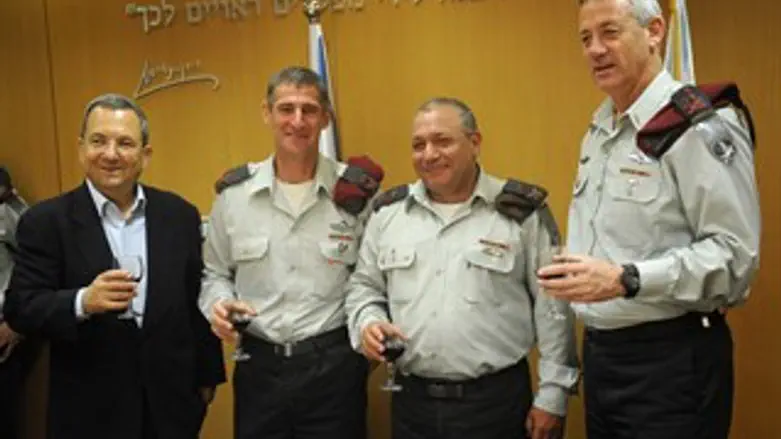
Major General Gadi Eisenkot, 54, will become the Chief-of-Staff (COS) of the IDF in the spring. Prime Minister Benjamin Netanyahu approved his nomination upon the recommendation of Defense Minister Moshe Ya’alon as well as former IDF generals.
Born in Israel, Eisenkat was drafted into the IDF in 1978. He joined the Golani Brigade where he served in a variety of roles. During the 1982 Lebanon War he served as an officer and shortly afterwards, he became the commander of Golani’s Battalion 13. After commanding an infantry reserve brigade and regional brigade in the mid 1990s, he returned to Golani as its commander in 1997.
In 1999 Eisenkot was appointed Military Secretary to then-Prime Minister and Defense Minister Ehud Barak. Since then he has commanded the 366th Division and the West Bank Division. He was promoted to head of the Operations Directorate in June 2005. Following criticism over the conduct of Major General Udi Adam in the 2006 Lebanon War, Eisenkot was asked to replace him as General Commanding Officer (GOC) of the Northern Command.
On January 2013, following a short leave, he returned as Deputy Chief of General Staff, second only to outgoing COS Lt. Gen. Benny Gantz.
When he was appointed by then-COS Moshe Ya’alon as chief of the Judea and Samaria Division, an important position at the time of the Second Intifada, Eizenkot was one of the leaders of the “mowing the grass” approach to defeat Palestinian terrorism in the West Bank. This led to a halt in suicide attacks and to near-total calm at the end of the uprising in 2005 andfollowing the Second Lebanon War, he was sent to rehabilitate the Northern Command – a task he carried out successfully.
Eizenkot served as the head of the IDF’s Operations Directorate during the Second Lebanon War. He was among the very few who demanded that reserve forces be called up at the beginning of the war – to no avail. Despite that, he remained loyal to his commander and kept his criticism to discussions within the General Staff’s top brass. He also supported the destruction of Beirut’s Dahiya suburb and called for attacking Lebanese infrastructure as an act of deterrence. In fact he was one of the leading architects of the “Dahiya doctrine,” a military strategy advocating massive aerial strikes on all of the enemy’s assets in Lebanon in an attempt to halt the rocket and missile fire at Israel’s home front.
Nevertheless, Eizenkot has emphasized the importance of ‘limited military objectives’ and has urged the IDF command not to launch risky operations that would endanger the troops. Eizenkot forced ‘limited objectives’ during Operation Protective Edge, and rejected the idea of expanding the operation into a full-scale invasion in order to overthrow Hamas.
Eizenkot had a minor involvement in the embarrassing Harpaz document affair, but he was cleared of criminal involvement. While this matter could still delay his final appointment, the chances of that happening are low.
In all likelihood, the relative quiet that the IDF has benefited from in recent years will not last for long. Thus Eizenkot must capitalize on the support and legitimacy he enjoys to swiftly make necessary reforms in the IDF force structure. These reforms should transform and prepare the IDF to better confront its current challenges; fighting various non-state entities while at the same time continuing to develop its high-end capabilities for the less likely scenario of state-to-state conflict.
There are those who raise doubts in Eisenkot’s ability to deeply reform the IDF in such a way. They point out his role in planning the Second Lebanon War and Operation Protective Edge and some of the reoccurring faults in these operations. The critics point to an IDF preference to reach decision through stand-off fire rather than aggressive ground maneuvering. In both operations, the ground phase was delayed and when it was finally executed, it was done so in unimaginative ways which unnecessarily extended the fighting.
Eisenkot is expected to create an offensive and creative military. This change will allow for short and decisive operations that will achieve long-term deterrence in the future conflicts with Hezbollah and Hamas and with additional likely enemies such as the Islamic State and Jahbat al-Nusra. To achieve this, Eisenkot will have to enhance the performance of IDF ground forces in executing quick and decisive maneuvers in dense urban centers saturated with booby traps, snipers and advanced anti-tank missiles.
He will have to do this while also preparing the IDF for a possible popular uprising on the Palestinian front, as well as continuing to invest in the IDF’s long range strategic arm in order to deter and perhaps strike Iran.
In addition, Eisenkot faces continued battles over budget cuts that might force him to do more with less – he will therefore have to examine how to achieve a better ‘tail for teeth’ ratio.
However, Eisenkot is fortunate to have an excellent team beside him in a young and creative General Staff. Hopefully, Eisenkot’s style of leadership will engender trust and cooperation among the generals, and will encourage open debate and disagreement alongside mutual commitment.
Dr. Eitan Shamir, a senior research associate at the Begin-Sadat Center for Strategic Studies, is aprofessor of political studies at Bar-Ilan University and the former head of the National Security Doctrine Department in the Israeli Ministry of Strategic Affairs.
A BESA Center Perspectives Paper, published through the generosity of the Greg Rosshandler Family